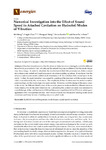Numerical Investigation into the Effect of Sound Speed in Attached Cavitation on Hydrofoil Modes of Vibration
| dc.contributor.author | Wang, W | |
| dc.contributor.author | Zhou, L | |
| dc.contributor.author | Wang, Z | |
| dc.contributor.author | Escaler, X | |
| dc.contributor.author | de la Torre, Oscar | |
| dc.date.accessioned | 2019-05-13T08:18:03Z | |
| dc.date.issued | 2019-05-09 | |
| dc.identifier.issn | 1996-1073 | |
| dc.identifier.issn | 1996-1073 | |
| dc.identifier.other | ARTN 1758 | |
| dc.identifier.uri | http://hdl.handle.net/10026.1/13837 | |
| dc.description.abstract |
It has been found recently that the dynamic behavior of a cavitating hydrofoil is different from that in pure water in that, not only are the natural frequencies different, but the mode shapes may also change. In order to elucidate the mechanism behind this phenomenon, finite element simulations were carried out based on acoustic–structure coupling equations. It was found that the structure and acoustic modes exhibit mode transitions with the variation of the sound speed in the cavity. Further, the mode transition was caused by coupling of the structure with the acoustic modes, which was induced by the vapor mode. The amplitude of the vibration near the mode transition point was high and the mode shape was easily excited. Moreover, with the change of the sound speed in the cavity, the different distributions of the acoustic pressure mode resulted in different structure mode shapes, even on the same transition line. Considering this, a sheet cavitation was simulated by a small change of the void fraction to 0.999 and the sound speed from 343 to 275 m/s to obtain good agreement with the experimental data. Both results showed that the second bending mode under cavitation conditions became a bending–torsion coupled mode. | |
| dc.format.extent | 1758-1758 | |
| dc.language | en | |
| dc.language.iso | en | |
| dc.publisher | MDPI | |
| dc.subject | hydrofoil | |
| dc.subject | natural frequencies | |
| dc.subject | mode shapes | |
| dc.subject | sound speed | |
| dc.subject | cavitation | |
| dc.title | Numerical Investigation into the Effect of Sound Speed in Attached Cavitation on Hydrofoil Modes of Vibration | |
| dc.type | journal-article | |
| dc.type | Journal Article | |
| plymouth.author-url | https://www.webofscience.com/api/gateway?GWVersion=2&SrcApp=PARTNER_APP&SrcAuth=LinksAMR&KeyUT=WOS:000469761700174&DestLinkType=FullRecord&DestApp=ALL_WOS&UsrCustomerID=11bb513d99f797142bcfeffcc58ea008 | |
| plymouth.issue | 9 | |
| plymouth.volume | 12 | |
| plymouth.publication-status | Published online | |
| plymouth.journal | Energies | |
| dc.identifier.doi | 10.3390/en12091758 | |
| plymouth.organisational-group | /Plymouth | |
| plymouth.organisational-group | /Plymouth/Faculty of Science and Engineering | |
| dcterms.dateAccepted | 2019-05-06 | |
| dc.rights.embargodate | 2019-5-29 | |
| dc.identifier.eissn | 1996-1073 | |
| dc.rights.embargoperiod | Not known | |
| rioxxterms.versionofrecord | 10.3390/en12091758 | |
| rioxxterms.licenseref.uri | http://www.rioxx.net/licenses/all-rights-reserved | |
| rioxxterms.licenseref.startdate | 2019-05-09 | |
| rioxxterms.type | Journal Article/Review |


